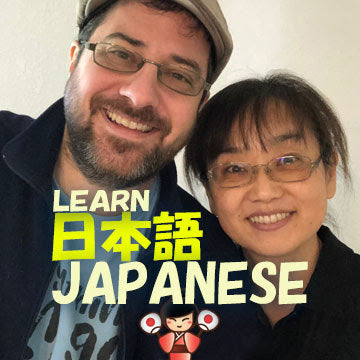
Kanji de Manga Volume 1
£8.00
Paperback. 144 pages. 7 x 5 inches.
-----------------
This award-winning series from Manga University uses original comic artwork to teach readers how to identify and write the most common Japanese kanji ideographs. Volume 1 introduces 80 basic kanji that all Japanese schoolchildren are required to learn before entering the third grade.
"A brilliant idea!" says Ronald A. Morse, retired professor of Japan Studies at UCLA and the University of Las Vegas, Nevada. "Japanese kanji — the written symbols adapted from Chinese — were originally drawings of images from real life. Japanese comic books and cartoons now provide fresh images to help us learn. Kanji de Manga uses today's manga images to make the kanji learning process fun and easy for otaku of all ages. This is a brilliant approach to learning the language."
Each page features its own comic strip, kanji pronunciation guide, stroke order, and English explanations.
Created by Glenn Kardy, editor of several volumes in the popular How to Draw Manga series, including Getting Started, the first book of its kind to be used at major universities in the United States (UCLA) and Japan (Waseda). Artwork by Chihiro Hattori, niece of legendary manga artist Eichi Fukui. Features a foreword by Tomonori Morikawa, Professor of International Studies at Waseda University, Tokyo.

Kanji de Manga Volume 2
£8.00
Paperback. 144 pages. 7 x 5 inches.
-----------------
This is the second volume in the award-winning series from Manga University that uses original comic artwork to teach readers how to identify and write the most common Japanese kanji ideographs. Volume 2 introduces 80 basic kanji that all Japanese schoolchildren are required to learn before entering the third grade.
"A brilliant idea!" says Ronald A. Morse, retired professor of Japan Studies at UCLA and the University of Las Vegas, Nevada. "Japanese kanji — the written symbols adapted from Chinese — were originally drawings of images from real life. Japanese comic books and cartoons now provide fresh images to help us learn. Kanji de Manga uses today's manga images to make the kanji learning process fun and easy for otaku of all ages. This is a brilliant approach to learning the language."
Each page features its own comic strip, kanji pronunciation guide, stroke order, and English explanations.
Created by Glenn Kardy, editor of several volumes in the popular How to Draw Manga series, including Getting Started, the first book of its kind to be used at major universities in the United States (UCLA) and Japan (Waseda). Artwork by Chihiro Hattori, niece of legendary manga artist Eichi Fukui.

Kanji De Manga Volume 4: The Comic Book That Teaches You How To Read And Write Japanese! (v. 4)
£8.00
Paperback. 144 pages. 7 x 5 inches.
-----------------
Our award-winning series moves forward with an all-new selection of 80 kanji geared toward intermediate learners of the language. Upon completion of this and the previous three volumes, students will have learned a total of 320 kanji, enough to prepare them for the advanced levels of the official Japanese Language Proficiency Test.
"A brilliant idea!" says Ronald A. Morse, retired professor of Japan Studies at UCLA and the University of Las Vegas, Nevada. "Japanese kanji — the written symbols adapted from Chinese — were originally drawings of images from real life. Japanese comic books and cartoons now provide fresh images to help us learn. Kanji de Manga uses today's manga images to make the kanji learning process fun and easy for otaku of all ages. This is a brilliant approach to learning the language."
Each page features its own comic strip, kanji pronunciation guide, stroke order, and English explanations.
Created by Glenn Kardy, editor of several volumes in the popular How to Draw Manga series, including Getting Started, the first book of its kind to be used at major universities in the United States (UCLA) and Japan (Waseda). Artwork by Chihiro Hattori, niece of legendary manga artist Eichi Fukui.

Kanji de Manga Volume 6: The Comic Book That Teaches You How to Read And Write Japanese!
£8.00
Paperback. 144 pages. 7 x 5 inches.
-----------------
Another 80 kanji are featured in the sixth volume of Manga University's award-winning series. Upon completion of this and the previous five volumes, students will have learned a total of 480 kanji, enough to prepare them for the advanced levels of the official Japanese Language Proficiency Test.
"A brilliant idea!" says Ronald A. Morse, retired professor of Japan Studies at UCLA and the University of Las Vegas, Nevada. "Japanese kanji — the written symbols adapted from Chinese — were originally drawings of images from real life. Japanese comic books and cartoons now provide fresh images to help us learn. Kanji de Manga uses today's manga images to make the kanji learning process fun and easy for otaku of all ages. This is a brilliant approach to learning the language."
Each page features its own comic strip, kanji pronunciation guide, stroke order, and English explanations.
Created by Glenn Kardy, editor of several volumes in the popular How to Draw Manga series, including Getting Started, the first book of its kind to be used at major universities in the United States (UCLA) and Japan (Waseda). Artwork by Chihiro Hattori, niece of legendary manga artist Eichi Fukui.

Kanji De Manga Volume 5: The Comic Book That Teaches You How To Read And Write Japanese!
£8.00
Paperback. 144 pages. 7 x 5 inches.
-----------------
Another 80 kanji are featured in the fifth volume of Manga University's award-winning series. Upon completion of this and the previous four volumes, students will have learned a total of 400 kanji, enough to prepare them for the advanced levels of the official Japanese Language Proficiency Test.
"A brilliant idea!" says Ronald A. Morse, retired professor of Japan Studies at UCLA and the University of Las Vegas, Nevada. "Japanese kanji — the written symbols adapted from Chinese — were originally drawings of images from real life. Japanese comic books and cartoons now provide fresh images to help us learn. Kanji de Manga uses today's manga images to make the kanji learning process fun and easy for otaku of all ages. This is a brilliant approach to learning the language."
Each page features its own comic strip, kanji pronunciation guide, stroke order, and English explanations.
Created by Glenn Kardy, editor of several volumes in the popular How to Draw Manga series, including Getting Started, the first book of its kind to be used at major universities in the United States (UCLA) and Japan (Waseda). Artwork by Chihiro Hattori, niece of legendary manga artist Eichi Fukui.

Kana de Manga
£8.00
Paperback. 144 pages. 7 x 5 inches.
-------------------
Great for beginners!
American pop culture is turning Japanese. Every day, millions of kids spend hours watching translated anime on Cartoon Network and reading telephone book-sized comics called manga. From Spirited Away to Shonen Jump, if the label says "Made in Japan," it's cool.
But what if you want to enjoy anime and manga in its original language? Written Japanese consists of three scripts: the phonetic hiragana and katakana syllabaries, each comprised of 46 characters (collectively known as kana); and kanji, a complex set of characters based on Chinese ideographs. Hiragana and katakana are the true "ABCs of Japanese," as they can be used to write complete sentences. Children in Japan learn to read and write hiragana and katakana long before they are introduced to kanji. Most manga targeted toward the youngest readers in Japan are also written completely in kana.
Kana de Manga makes learning hiragana and katakana easy and fun for students who already enjoy Japanese comics. Each page has a humorous manga illustration representing a word that begins with the hiragana or katakana character featured prominently at the top. A brief explanation accompanies each drawing; the English equivalent of the word is given, and there is a work area where students can practice writing the characters.
Written by Glenn Kardy, editor of several volumes in the popular How to Draw Manga series, including Getting Started, the first book of its kind to be used at major universities in the United States (UCLA) and Japan (Waseda). Artwork by Chihiro Hattori. Features a foreword by Ronald A. Morse, retired professor of Japan Studies at UCLA and the University of Nevada, Las Vegas.


